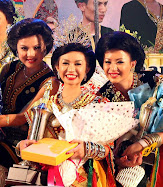
Here Mendoza was seen freeing a number of hostages including an eldery man, children and eldery women. The sharpshooters of the Phillippines SWAT team had golden opportunity to end the siege without loss of lives among the hostages had they took advantage of the situation where Mendoza was standing on the doorstep of the ill-fated bus - with his M16 hanging down..
The Shootout.... Pity the innocent passengers/tourists
The tragic aftermath....
It was a sad day for those Hong Kong tourists. They were looking for a good time in Manila, Phillipinnes but instead experienced the most harrowing moments in their life.
This shows that kidnapping in the Phillipinnes not only happened in the jungles of Basilan and Jolo by the Abu Sayyaf or other pure lawless elements - but also in the middle of Manila's concrete jungles.
The Phillippines SWAT is also not good and not professional in rescuing the hostages - they fires indiscriminately, it is possible that some hostages died not because of the kidnapper's bullets but due to the SWAT team own bullets.
This firing indiscriminately while on a hostage rescuing mission also happened during the Abu Sayyaf hostages crisis in 2000 and 2001. According to the hostages, the Phillipinnes army, fired at random - endangering the life of the hostages!! They should follow USA's SWAT Special Weapons and Tacticals Teams - who will never fire blindly, but will deploy the highly trained sniper teams - capable of firing accurately on small moving targets from a distance of 1 kilometre!!!
Ten things the Philippines bus siege police got wrong
BBC the British Broadcasting Corporation reported that a security analyst, Charles Shoebridge who has worked in counter-terrorism with the British Army and Scotland gave his opinions on that tragic crisis.
Shoebridge said the officers involved in Manila's bus siege showed great courage - but they were not properly trained or equipped for the task.
Here are 10 areas where, in his view, they could have done better.
1. Determination
The first officers who tried to storm the bus were driven out by gunshots from the hostage taker, former policeman Rolando Mendoza. "They showed great courage to go on board. It's very crowded, just one aisle down the middle of the bus. But once you get on board it's not unexpected you are going to be fired at. Squads like this have to be made up of very special people, specially trained and selected for their characteristics of courage, determination and aggression. In this case they acted as 99% of the population would have, which was to turn round and get out. They didn't seem to have the necessary determination and aggression to follow the attack through."
2. Lack of equipment
The police spent a long time smashing the windows of the bus, whereas explosive charges (known as frame charges) would have knocked in windows and doors instantly. "They had no ladders to get through the windows. They smashed the windows but didn't know what to do next," Mr Shoebridge says. "They almost looked like a group of vandals." Their firearms were also inappropriate - some had pistols, some had assault rifles. Ideally they would have carried a short submachine gun, suitable for use in confined spaces.
3. Lost opportunity to disarm the gunman
Mendoza's gun was not always raised. There were numerous opportunities to restrain the gunman, Mr Shoebridge believes. "The negotiators were so close to him, and he had his weapon hanging down by his side. He could have been disabled without having to kill him."
4. Lost opportunity to shoot the gunman
The video of the drama also shows there were occasions when the gunman was standing alone, during the course of the day, and could have been shot by a sharpshooter. "You are dealing with an unpredictable and irrational individual. The rule should be that if in the course of negotiations an opportunity arises to end the situation decisively, it should be taken," Mr Shoebridge says. Either this possibility did not occur to the officers in charge, he adds, or they considered it and decided to carry on talking.
5. Satisfying the gunman's demands
"I wondered why the authorities just didn't give in to all of his demands," says Charles Shoebridge. "A promise extracted under force is not a promise that you are required to honour. Nobody wants to give in to the demands of terrorists, but in a situation like this, which did not involve a terrorist group, or release of prisoners, they could have just accepted his demands.
He could be reinstated in the police - and then be immediately put in prison for life for hostage taking." The Philippines authorities did in fact give in to the gunman's demands, but too little, too late. One message promised to review his case, while he wanted it formally dismissed. A second message reinstating him as a police officer only arrived after the shooting had started.
6. Televised proceedings
The gunman was able to follow events on television, revealing to him everything that was going on around him. This was a "crucial defect in the police handling", Mr Shoebridge says. He adds that police should always consider putting a barrier or screen around the area, to shield the scene from the cameras and keep the hostage taker in the dark.
7. No element of surprise
It was clear to the gunman what the police were doing at all times, not only because the whole incident was televised, but also because they moved "laboriously slowly", Mr Shoebridge says. The police did not distract him, so were unable to exploit the "crucial element of surprise".
8. Safeguarding the public
This boy, a bystander, was hit by a stray bullet At least one bystander was shot, possibly because the public was allowed too close. The bullet from an M16 rifle, as carried by the gunman, can travel for about a mile, so preventing any risk of injury would have been difficult, Mr Shoebridge says, but a lot more could have been done. "When you saw the camera view from above, it was clear there was little command and control of the public on the ground," he says.
9. Using the gunman's brother to negotiate
Relatives and close friends can be a double-edged sword, Mr Shoebridge says. While they may have leverage over the hostage taker, what they are saying cannot be easily controlled. In this case, the gunman's brother was included in the negotiations - however, at a certain stage he became agitated and police started to remove him from the scene. The gunman saw this on television, and became agitated himself. According to one report he fired a warning shot.
10. Insufficient training
In some parts of the Philippines, such as Mindanao, hostage taking is not an uncommon occurrence, so the country has some forces that are well trained in the necessary tactics. The detachment involved in Monday's incident clearly was not, says Mr Shoebridge. After smashing the windows, one of the officers eventually put some CS gas inside, though "to what effect was not clear" he says. A unit involved in this work, needs to be "trained again and again, repeatedly practising precisely this kind of scenario," he says.
On Tuesday 23rd August 2010, Phillipinnes security forces stormed a bus packed with Hong Kong tourists to end a dramatic hostage crisis that unfolded live on global television, leaving eight people and the gunman dead.
The day-long ordeal on Monday 22 August 2010, began when a disgruntled ex-policeman armed with an M-16 assault rifle and dressed in combat pants hijacked the bus in Manila's tourist district in a desperate bid to get his job back.
Negotiations broke down after nightfall when the gunman, former senior police inspector Rolando Mendoza, began shooting and commandos were forced to storm the bus, firing dozens of bullets of their own into the vehicle. 'I shot two Chinese. I will finish them all if they do not stop,' Mendoza told a local radio station as the police assault was about to get under way.
Police said a sniper shot Mendoza dead after he used his captives as 'human shields' in the final moments of the 12-hour standoff.
Philippine President Benigno Aquino said eight tourists were confirmed killed, while the Red Cross reported another seven were in hospital with unspecified injuries. Nine hostages, including children, were freed at various times throughout the day from the bus that was parked at Rizal Park, a popular tourist destination just a few blocks from police headquarters.
The Filipino bus driver jumped out of a window and escaped moments before police stormed the vehicle, with his escape and the rest of the crisis broadcast live on television.
China condemns Manila hijack
As expected, CHINA on Tuesday strongly condemned a Philippine bus hijacking that left eight Hong Kong tourists dead as an 'atrocity', and urged Manila to ensure Chinese citizens are safe.
The Chinese embassy said: 'The Chinese government strongly condemns the atrocity by the hostage-taker, expresses grave condolences to the victimised Hong Kong compatriots and conveys profound sympathy to the bereaved families.'
'The Chinese side has urged the Philippine side to take concrete measures to ensure the safety and security of the Chinese citizens in the Philippines,' it said in a statement.
Philippine President Benigno Aquino said early on Tuesday that he has sent an apology to Hong Kong Chief Executive Donald Tsang for what had happened, adding that he has ordered the Philippine Department of Foreign Affairs to extend all possible assistance to the victims.
The president made the remarks at a press conference after meeting with police officials and Manila Mayor Alfredo Lim, reported Xinhua news agency.
Philippine hostage crisis ended here on Monday night with eight hostages were killed, seven injured, one of whom is in critical conditions, Philippine government officials said.

































2 comments:
First thing that came into my mind: they had live footage?! How stupid can they get?! The hickjaker gets to see or know everything!!
Yes Lorna - it was the same like the 1972 Munich Olympics massacre of Israeli athletes by Palestinian militants at the game village. The Munich rescue operations was also shown live on TV and the terrorists knew the Police every movement. The same goes to the Mumbai tragedy by Pakistani Militants. And now Mendoza was given the benefit again by monitoring the police siege through the Live Telecast.
And Mendoza's gun was not always raised. There were numerous opportunities to restrain the gunman. He could have been disabled without having to kill him as at sometimes during the crisis - the negotiators were so close to Mendoza and they could just grab him and overpower him to prevent loss of innocent lives.
The video of the drama also shows there were occasions when the gunman was standing alone, during the course of the day, and could have been shot by a sharpshooter.
Post a Comment